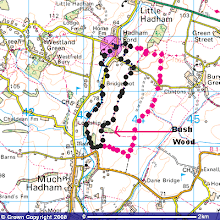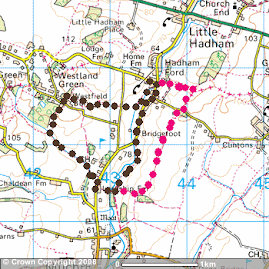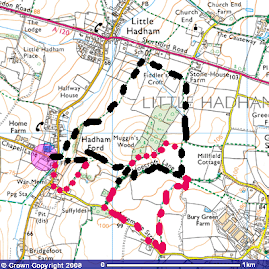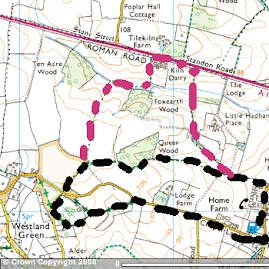Final part of this brief guide to birdwatching around Stortford. Today, places further afield that offer a really good opportunity to build a good day list.
Amwell Herts and Middlesex Wildlife Trust Reserve:
https://www.hertswildlifetrust.org.uk/nature-reserves/amwell
This reserve is found between Stansted Abbots and Ware, old gravel pits adjacent to the River Lea. Presently the hides are closed but still a good viewing point to look out over the main lake with mud, reedbeds and islands.
Birds to be found through the winter: cormorant, mallard, shoveller, wigeon, tufted duck, gadwall, teal, coot, moorhen, lapwing, black headed gull, herring gull, lesser black backed gull, grey heron, little egret, reed bunting, finches and tit species including siskin and redpoll, Canada goose, Egyptian goose, greylag goose, shelduck,
However, as winter temperatures become colder this reserve can pull in some good wintering wildfowl. Goldeneye are annual visitors, sometimes in reasonable numbers. Even more impressive is that most years, often after a really cold snap in The Netherlands, smew can be found, usually in the deeper water to the right of the viewing point and often in front of the Gladwin Hide, presently closed. Another good winter visitor will be goosander, often found on the lake further north.
Birds of prey include Common buzzard, Red Kite and Peregrine throughout the winter along with resident kestrel and frequent sparrowhawk. From the viewing point, scan the wooded hills in the distance where also occasional ravens can be found.
The highlight bird of winter is the bittern. Rarely seen but its "booming" call can be heard in the reedbeds. If icy, it can be seen, along with the secretive water rail coming out to wander on the ice.
Once finished at the viewing point carry on along the path left after the bridge. Siskins and redpolls feed in these trees. There is a fork in the track. Right takes you to another lake that can be viewed from the old Buntigford railway line where pochard feed along with other wildfowl. Then, head back to the river and turn right. After half a mile there is access to another worked out gravel pit near the lock gates and lock keepers cottage. This is where goosanders can be found, usually near the overhanging trees.. Retrace your steps and cross the river by the footbridge into a small wood. Alder trees here can be full of siskins and, as always, worth checking for the lighter and greyer Lesser redpoll.
Wrap up warm and take the binoculars as there is always plenty to find.
 |
| Shelduck |
 |
| Female or first year smew at Amwell |
 |
| Stunning male adult smew at Amwell several winters ago |
https://www.essexwt.org.uk/nature-reserves/hanningfield
Found between Chelmsford and Wickford and about an hours drive. Visitors' Centre, good paths and plenty of winter wildfowl including goosander, pintail, shoveller etc as well as occasional smew. Definitely a binocular day but there is a Causeway over the western corner of the reservoir and this is best place to encounter goosander. Used to be able to park on this road and watch from the comfort and warmth of the car. Not sure of that is still the case, but a pavement on both sides mean parking nearby and a wander back. Egrets and herons here, too.
Very flat here and with a northerly breeze on a cold winter's day it can be nerve bitingly cold!! Wrap up warm.
 |
| Little egret |
Stocker's Lake, near Rickmansworth:
https://www.hertswildlifetrust.org.uk/nature-reserves/stockers-lake
A super place this, just off the M25. a well established path all the way around with hides (presumed closed.) Star birds here are wintering wildfowl such as goldeneye, goosander, red crested pochard as well as plenty of ring necked parakeets.
The path here offers great views of the lake. At the wooded end near the swimming pool carpark there are trees growing from the water and it is usually here that the goosanders can be found. Also, regular sightings of Lesser spotted woodpecker.
Highly recommended for a half day trip.
 |
| A pair of male red crested pochard, not showing their bright red bill |
Tyttenhanger, near St. Albans:
https://www.hnhs.org/herts-bird-club/site/tyttenhanger-gravel-pits
Accessed off the A414 between Hatfield and St. Albans. A large site with old gravel pits, reed beds, woodland and grassy areas. The last few Hertfordshire tree sparrows can be found here, where there is a specific feeding station to keep them local. Numbers monitored regularly. Some waders overwinter here along with occasional whooper and Bewick's swans . The woodland on the far side gives good, if distant views of the lakes and then there is a footpath causeway over towards the farm where golden plover usually roost in good numbers. This is a regularly watched site and for up to date information go to https://www.hnhs.org/herts-bird-club/recordviewarchive to see what is present. This page on the Herts Bird Club updates throughout the day. Here it is at 10.30am on Wednesday 30th Sept. There are several locals who bird this site daily, as there are at Amwell so information is usually very up to date
 |
| Bewick's swan (these from a long walk in Poland: cold and foggy!) |
 |
| Pair of goosander, drake right. Another from Gdansk Bay, Poland |
 |
| Short eared owl |
 |
| SEO fly past. Superb bird |
 |
| Early morning redshank at Rainham Marsh |






















































































